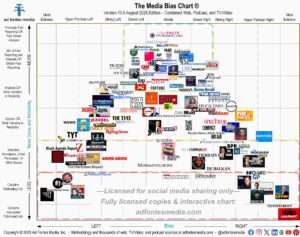Stakeholder Statement
We rate the news for reliability and bias, and the first question astute observers will ask is, “How can I trust that YOU aren’t biased?”
Another question people ask is how we are funded, because a basic principle of media literacy is to consider the source and how it serves the interests of its owners. This document describes our thinking and commitments around issues of bias and conflicts of interest.
We are biased. All people and organizations are biased, and the first step to mitigating bias is recognizing it. We are not just politically biased, but also biased in favor of our stakeholders. All organizations get money from somewhere, whether from investors, donors, or customers. Every organization is owned by someone, or by a group of people. Therefore, every organization, including ours, has stakeholders. And every organization tries to satisfy the interests of its stakeholders.
Certain organizations are in the business of trying to be as fair and objective as possible, and these include journalism outlets and third-party rating organizations. We are a third-party rating organization of journalism outlets, so people rightfully expect us to do everything we can to maintain fairness and objectivity.
Organizations like ours can implement mechanisms to mitigate bias and potential conflicts of interest. For us, the most important mechanisms are 1) methodological transparency, 2) demographic and political diversity among analysts and staff, and 3) distribution of financial stakeholders.
The lengths to which we go to mitigate our political bias are well documented in our methodology descriptions, which you can read about here.
This particular document addresses how we mitigate concerns of improper influence and conflicts of interest through the distribution of financial stakeholders. Namely, this document discusses the sorts of conflicts of interest that could arise out of our need to fund our operations and make money.
The work we do requires money — it takes the work of a lot of humans and the development and maintenance of a lot of software to rate the news. Early on, we figured that in order to become a long-term, viable organization, we needed to earn and raise money in a way that was both sustainable and which limited potential conflicts of interest.
For these reasons, we decided to be a for-profit company (we are a Colorado Public Benefit Corporation) whose customers are distributed across the entire news landscape. These customers are individual news consumers, educators, researchers, publishers, marketers, and social media companies.
These customers are our stakeholders because they need to know where we rate news content in order to make decisions. But each of these stakeholders pay us money to rate the news in one form or another, so a potential conflict of interest could arise if we felt incentivized to rate a news source higher or lower because of who was paying us to rate it.
But customers are not the only source of our funding, and therefore are not our only stakeholders. Over the years, we have raised money from time to time. Since our inception in 2018, we have raised money from many stakeholders in the form of both donations and investment capital.
In 2018 we raised $32,000 through donations from over 500 individuals to an Indiegogo crowdfunding campaign that provided perks like posters and mugs.
Subsequently, we raised a more significant amount of money through investment capital. Between 2020 and 2024, we have raised over $600,000 through several equity crowdfunding campaigns on a platform called WeFunder. We have over 800 individual investors through WeFunder, with some investing as little as $100.
Concurrently to the WeFunder campaigns, we have raised private investment capital from angel investors and mission-driven venture and impact funds. As of July 2025, we have raised close to $7M from over 30 of these individuals and investment funds.
In total, over 1,300 donors and investors are our stakeholders because they believe in our mission and are counting on us to make a return on their investment.
We do not have just one major benefactor, donor, or customer as a stakeholder. We have thousands of people to whom we are accountable.
As a result, the action of giving an unfair or unduly preferential rating to one news outlet would be counter to the interests of all of our other stakeholders, such as our individual news consumers, other publishers and advertisers, educators, researchers, social media platforms, donors, and investors.
Because we have so many distributed financial stakeholders, it is in the best interest of all of our stakeholders for us to fairly and consistently rate all news sources exactly according to our methodology all the time, no matter who our particular customer is at a particular time. Our most valuable asset as a company is our reputation for rating news sources fairly and consistently. It is in our best interest as a company to rate all sources exactly where our methodology determines they should be rated.
Having many types of customers and many individual investors mitigates the potential for conflicts of interest. We are accountable to each one of them. If you are a customer or investor of ours, we are accountable to you.

